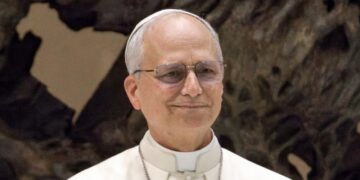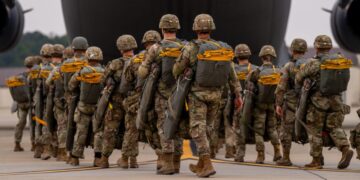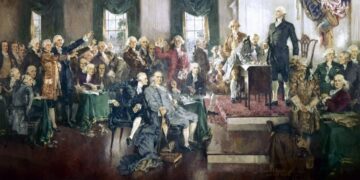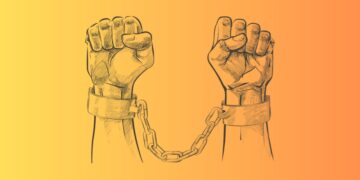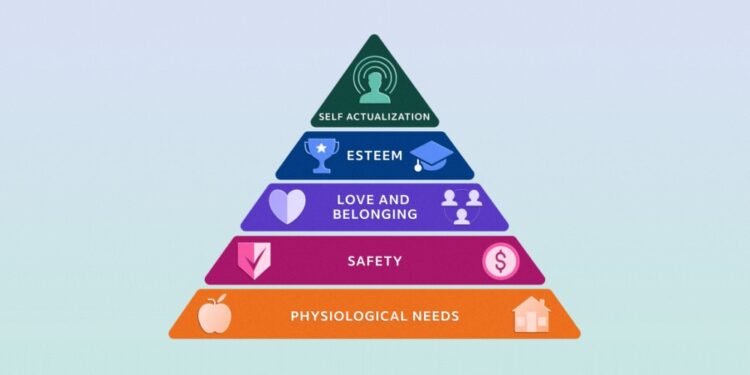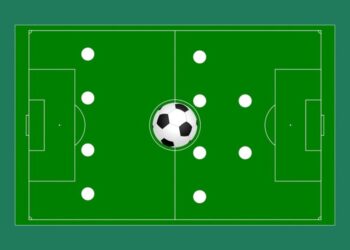Maslow’s hierarchy of needs is a motivational theory in psychology comprising a five-tier model of human needs, often depicted as hierarchical levels within a pyramid. The hierarchy was originally conceived by American psychologist Abraham Maslow in 1943. Maslow had a humanistic approach to psychology, and his work put focus on the whole person instead of individual psychological symptoms. His hierarchy of needs describes several levels of the human experience, with examples of how each need can be fulfilled. The corresponding theory poses each level must be sufficiently met before someone is prepared to tackle the next level.
The five hierarchical layers
From the bottom of the hierarchy upwards, the needs are physiological (food and clothing), safety (job security), love and belonging needs (friendship), esteem, and self-actualization. Needs lower down in the hierarchy must be satisfied before individuals can attend to higher needs.
1. Physiological needs
The foundation of Maslow’s pyramid comprises the physiological needs that are indispensable for survival. These include the need for air, water, food, sleep, and shelter. Until these primal needs are met, individuals are driven by an instinctual pursuit of satisfying them. “A person who is lacking food, safety, love, and esteem would most probably hunger for food more strongly than for anything else.” Maslow explained in his paper. Everything else, he posited, has to come after.
2. Safety needs
Once physiological needs are fulfilled, the focus shifts to safety and security. This layer encompasses physical safety, financial stability, health, and protection from harm. In a world fraught with uncertainties, individuals seek environments where they feel secure and free from threats. Maslow argued that it’s this level of safety-seeking that leads humans to prize systems that bring order to their existence, perhaps in the form of law or religion. Some challenges to this level, he suggested, could be “wild animals, extremes of temperature, criminals, assault and murder, (and) tyranny.”
3. Needs of belonging
Once basic survival and a modicum of security are established, human needs change a little bit. Human beings are inherently social creatures, and the need for social connections becomes prominent once safety needs are satisfied. Love, affection, and a sense of belonging within families, friendships, and communities contribute to emotional well-being. In this model, Maslow assumed, with the fulfillment of one level, humans will generally develop a longing to fulfill the next.
“Now the person will feel keenly, as never before, the absence of friends, or a sweetheart, or a wife, or children,” Maslow wrote. “He will hunger for affectionate relations with people in general, namely, for a place in his group, and he will strive with great intensity to achieve this goal. He will want to attain such a place more than anything else in the world and may even forget that once, when he was hungry, he sneered at love.”
4. Esteem needs
Esteem needs encompass two dimensions – self-esteem and the esteem bestowed by others. After cultivating a sense of belonging, individuals aspire to develop self-respect, confidence, and a belief in their abilities. Moreover, external recognition and achievements contribute to a positive self-concept. “Satisfaction of the self-esteem need leads to feelings of self-confidence, worth, strength, capability and adequacy of being useful and necessary in the world.” Maslow wrote.
5. Self-actualization needs
The pinnacle of the hierarchy is self-actualization, often described as the realization of one’s fullest potential. This stage involves pursuing personal growth, creativity, morality, and a deeper understanding of oneself and the world. Self-actualized individuals are driven by intrinsic motivations and a quest for meaning. Self-actualization can mean many things, but many of the examples center around a desire to explore, create or expand ones skills.
Concepts like beauty, aesthetics and discovery translate into real-world examples like art, learning a new language, refining one’s talents and becoming the best one can be. “A musician must make music, an artist must paint, a poet must write, if he is to be ultimately happy,” Maslow wrote. “What a man can be, he must be. This need we may call self-actualization.” (Despite the pronouns, one assumes the process of self-actualization is also applicable to humans who are not men.)
Applications and significance
Aside from its psychological application, countless disciplines have found Maslow’s model to be a useful teaching tool. here are some applications of Maslow’s hierarchy of needs.
1. Psychology and counseling
Maslow’s theory has been instrumental in guiding therapeutic approaches. Mental health professionals utilize the hierarchy to diagnose underlying issues and tailor interventions that address unmet needs, facilitating personal growth and well-being.
2. Education
Educators leverage Maslow’s framework to create conducive learning environments. By addressing students’ diverse needs – from physiological well-being to self-esteem – educators can enhance engagement and foster a positive educational experience.
3. Organizational behavior and management
Businesses apply Maslow’s theory to optimize employee motivation and satisfaction. A workplace that acknowledges both financial security and the need for esteem and self-actualization can foster a productive and harmonious atmosphere.
4. Consumer behavior and marketing
Understanding consumer needs is paramount in marketing. Maslow’s hierarchy guides marketers in crafting strategies that resonate with consumers’ aspirations, influencing purchasing decisions.
5. Cultural and individual variations
Maslow’s theory has been adapted to account for cultural and individual variations in needs hierarchy. Different cultures may prioritize certain needs over others, and personal experiences can shape the order and significance of needs.
6. Race and social justice
Race and social justice advocates have used this hierarchy as a model to explain how basic inequalities significantly hinder underserved people’s upward mobility. Some people in this sphere reframe Maslow’s hierarchy to be one of rights or inequities to better illustrate where and how things like discrimination lead to the denial of these needs.
Critiques and contemporary perspectives
While Maslow’s Hierarchy of Needs has undoubtedly enriched psychology and related fields, it has not been immune to criticism. Scholars have questioned its universality, arguing that the hierarchy may not apply universally across cultures. Additionally, modern research has expanded upon Maslow’s work, exploring the dynamic interplay between needs and the potential for regression to lower levels due to life circumstances.
Conclusion
Abraham Maslow’s hierarchy of needs remains an enduring contribution to our understanding of human motivation, behavior, and personal development. While not without its critiques, the framework’s enduring appeal lies in its ability to capture the intricate tapestry of human desires and aspirations. As society evolves and our understanding of psychology deepens, Maslow’s theory continues to be a guiding beacon, offering valuable insights into the essence of what drives us as human beings.






































































































